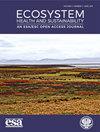巴拉顿湖(匈牙利)休闲捕鱼不利营养平衡的管理方案
IF 3.4
2区 环境科学与生态学
Q1 ECOLOGY
引用次数: 1
摘要
垂钓者将各种类型的地面诱饵装载到湖泊中,但这些材料的生态作用往往被忽视。因此,本研究的目的是对中欧最大的湖泊(匈牙利巴拉顿湖)中钓鱼者使用的鱼饵进行定量和定性评估,估计休闲钓鱼的年营养平衡,并将该来源的营养负荷与总外部负荷联系起来。我们的研究表明,常见的钓饵在营养成分和摩尔氮磷比(N:P)方面存在很大差异。休闲捕鱼的净养分平衡为+19.3 t N - 1年和+5.2 t P - 1年,分别相当于估算的年总N和P负荷的0.7%和3.2%。如果目前的趋势继续下去,营养负荷率可能会翻倍:垂钓者将使用比现在多20%的营养含量更高的鱼饵,而且在捕获鱼后也会表现出更大的放生倾向。将饵料用量控制在1.5 kg day - 1以内,选择磷(<0.3%)和氮(<1.5%)含量较低的饵料,可实现渔业管理的可持续营养平衡。本文章由计算机程序翻译,如有差异,请以英文原文为准。
Management options for the unfavorable nutrient balance of recreational fishing in Lake Balaton (Hungary)
ABSTRACT Various types of ground baits are loaded to lakes by anglers, but the ecological role of these materials is often overlooked. Thus, the aims of this study were to conduct a quantitative and qualitative assessment of the baits used by anglers in the largest lake of Central-Europe (Lake Balaton, Hungary), estimate the annual nutrient balance of recreational fishing, and relate the nutrient loading from this source to the total external load. Our study demonstrated that popular angler baits varied substantially in their nutrient contents and in their molar nitrogen to phosphorus (N:P) ratios. The net nutrient balance of recreational fishing was +19.3 t total N year−1 and +5.2 t total P year−1, equivalent to 0.7% and 3.2% of the estimated total annual N and P loads, respectively. The rate of nutrient loading may be doubled if the present trends continue: anglers will use 20% more bait with an even higher nutrient content and will also show higher propensity to release the fish after catching. In turn, sustainable nutrient balance of fisheries management could be achieved by limiting the anglers’ bait use to 1.5 kg day−1 and restricting baits to those which have relatively low P (<0.3%) and N (<1.5%) contents.
求助全文
通过发布文献求助,成功后即可免费获取论文全文。
去求助
来源期刊

Ecosystem Health and Sustainability
Environmental Science-Management, Monitoring, Policy and Law
CiteScore
7.10
自引率
2.00%
发文量
40
审稿时长
22 weeks
期刊介绍:
Ecosystem Health and Sustainability publishes articles on advances in ecology and sustainability science, how global environmental change affects ecosystem health, how changes in human activities affect ecosystem conditions, and system-based approaches for applying ecological science in decision-making to promote sustainable development. Papers focus on applying ecological theory, principles, and concepts to support sustainable development, especially in regions undergoing rapid environmental change. Papers on multi-scale, integrative, and interdisciplinary studies, and on international collaborations between scientists from industrialized and industrializing countries are especially welcome.
Suitable topics for EHS include:
• Global, regional and local studies of international significance
• Impact of global or regional environmental change on natural ecosystems
• Interdisciplinary research involving integration of natural, social, and behavioral sciences
• Science and policy that promote the use of ecological sciences in decision making
• Novel or multidisciplinary approaches for solving complex ecological problems
• Multi-scale and long-term observations of ecosystem evolution
• Development of novel systems approaches or modeling and simulation techniques
• Rapid responses to emerging ecological issues.
 求助内容:
求助内容: 应助结果提醒方式:
应助结果提醒方式:


